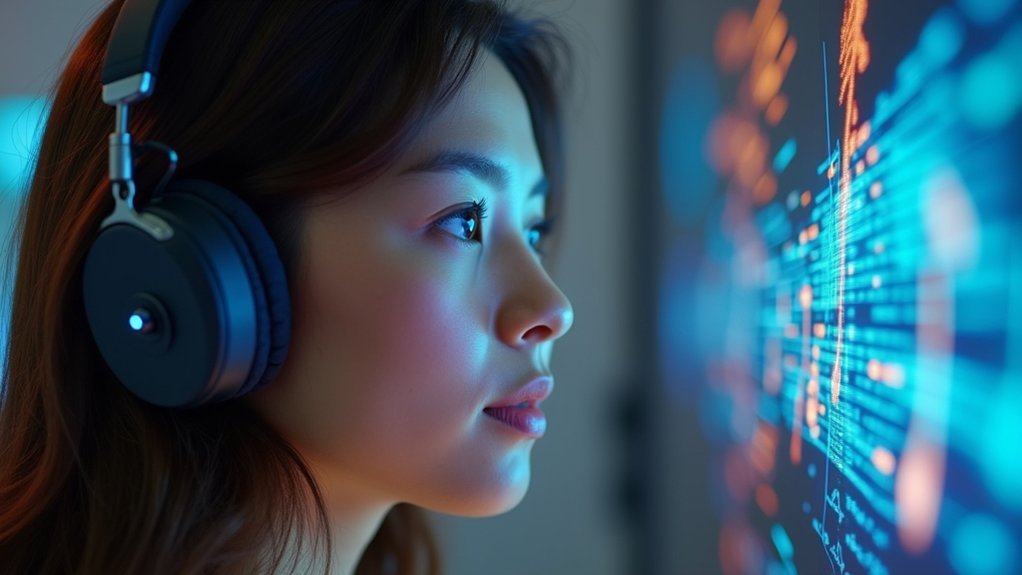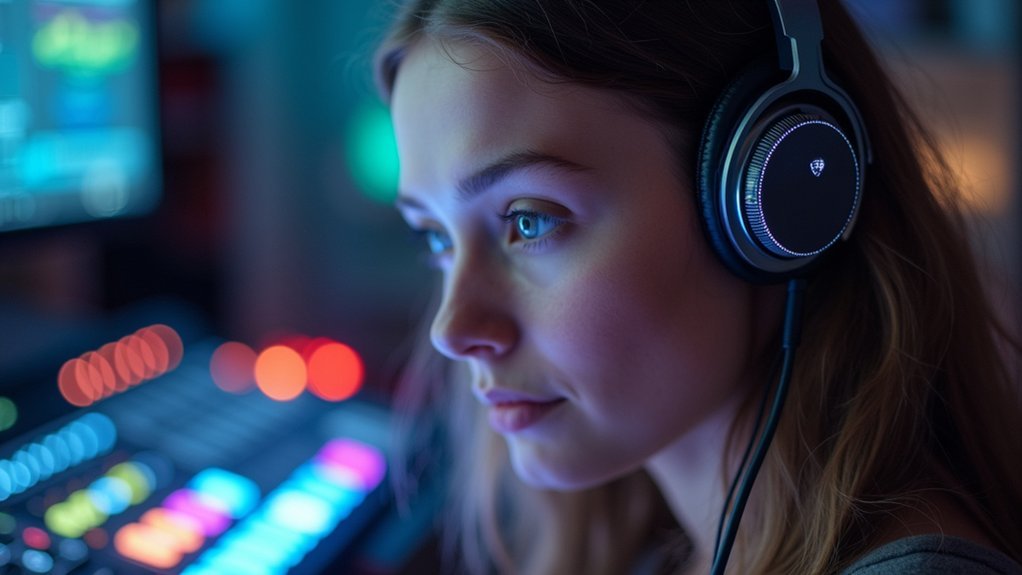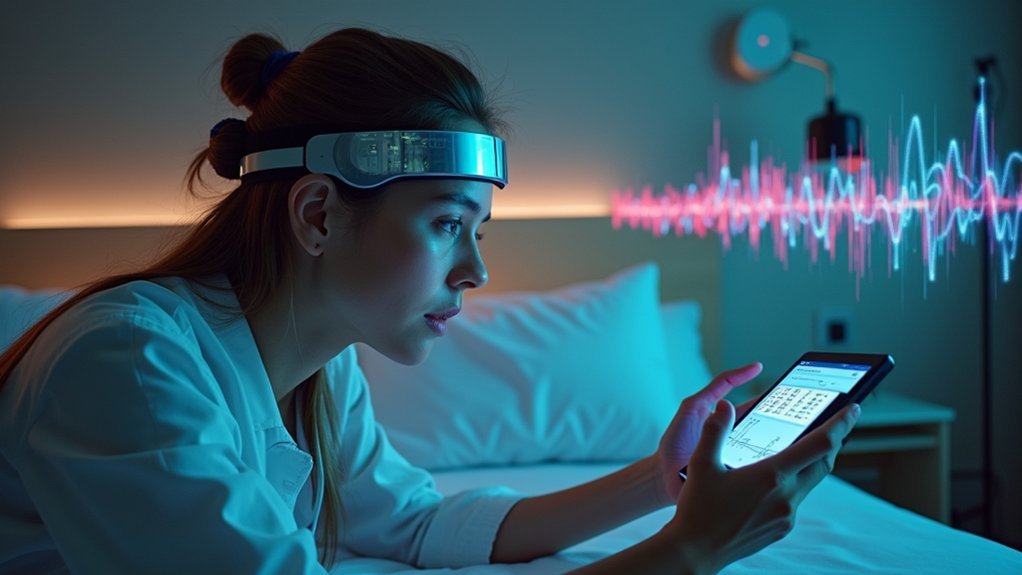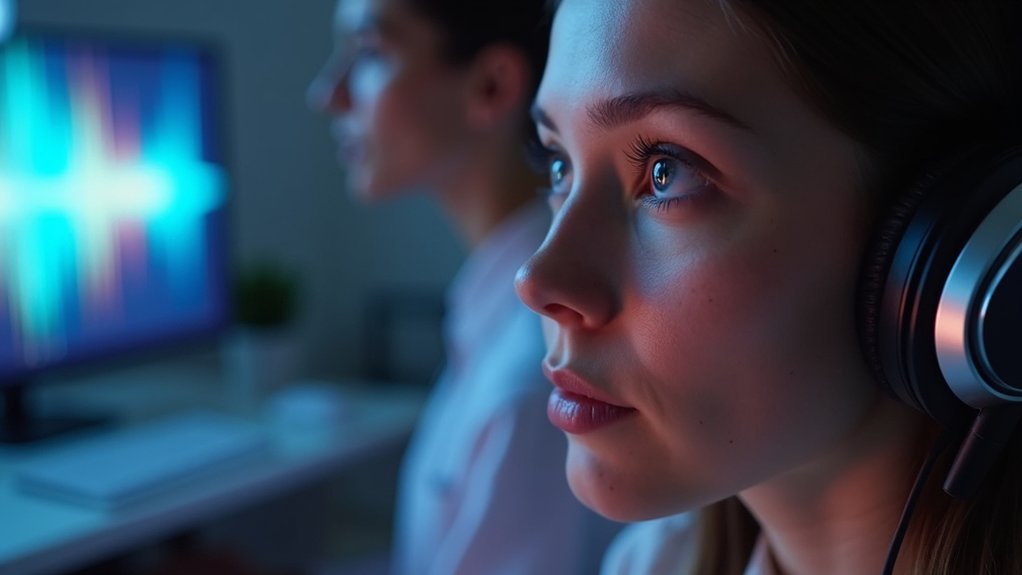Eye-controlled music interfaces allow paralyzed individuals to create music using only their brainwaves. By focusing on flashing icons, your brain signals are detected through electrodes and translated into musical selections in real time. This Brain Computer Music Interface (BCMI) technology, developed at Plymouth University, costs around $15,600 for high-end devices, though affordable alternatives exist. You’ll discover how this innovative technology offers renewed creative expression, emotional well-being, and social connection for those with severe disabilities.
The Science Behind Eye-Controlled Musical Interfaces

While traditional musical instruments require physical movement to produce sound, eye-controlled musical interfaces harness the power of brainwaves to create music without physical interaction.
The brain computer music interface (BCMI) uses electrodes on the back of your head to detect up to eight different brain wave frequencies when you focus on flashing icons on a screen.
Electrodes detect your brainwave patterns as you focus on flashing screen icons, transforming neural activity into musical commands.
This technology offers revolutionary creative expression opportunities for people with severe disabilities, particularly those with locked-in syndrome. As you concentrate on specific icons, the system interprets your brain activity through eye tracking and transforms it into real-time music generation.
Musicians then perform these selections from a computer monitor. After eleven years of development, this patient interaction system proves that technological barriers to artistic expression can be overcome, regardless of physical limitations.
Breaking Barriers: How BCMI Technology Works
The mechanics behind Brain Computer Music Interface technology represent an engineering marvel that transforms thought into sound. Positioned at the back of your head, electrodes capture faint electrical signals your brain produces when you focus on flashing icons.
The BCMI system can distinguish between eight different brain wave frequencies, translating these signals into musical selections. For paralyzed users, this breakthrough enables music creation solely through eye movements.
As you focus on different icons, the system interprets your attention and begins to generate music in real-time. Musicians then perform this computer-generated composition directly from their monitors.
Over eleven years of development at Plymouth University has refined this technology, making it increasingly accessible to those who previously couldn’t express themselves musically due to physical limitations.
From Thought to Symphony: Real-Time Music Generation

You’ll witness your brainwaves transform into musical notes as the BCMI captures your eye movements tracking flashing icons on screen.
Your gaze selections trigger real-time composition across eight different frequency options, creating a dynamic musical score.
Musicians then perform your mind’s melodies live, interpreting the computer-generated notation that reflects your thoughts and intentions.
Brainwaves Become Musical Notes
Modern science has transformed thoughts into music through the Brain Computer Music Interface (BCMI) developed at Plymouth University. This groundbreaking system enables patients with severe disabilities to create music in real-time by selecting snippets with their eyes while electrodes monitor their brain activity.
You’ll find the technology detects up to eight different brain wave frequencies. When you focus on flashing icons on the screen, each corresponding to different frequencies, you’re actually composing music with your mind.
Musicians then perform your created score displayed on a monitor, providing immediate feedback.
The BCMI offers more than just music—it’s a creative outlet enhancing social engagement for paralyzed individuals. Developers plan to make the software free to those purchasing the necessary hardware, with a potential £10,000 system cost.
Flashing Icons Trigger Composition
While staring at icons flashing at precise frequencies on a specialized screen, users trigger the BCMI system to translate their visual focus into musical elements. Your eye movements select different music snippets by detecting which of the eight possible brain wave frequencies you’re generating when focusing on specific flashing icons.
As you make selections, real-time music generation occurs, allowing musicians to interpret the score displayed on a monitor rather than traditional sheet music. This assistive technology was specifically designed for people with locked-in syndrome or limited mobility, offering creative expression when physical movement isn’t possible.
The immediate feedback creates a dynamic composition experience – you think, you look, music happens. This technological breakthrough transforms brain activity into artistic output, providing both creative and social engagement opportunities for those with severe disabilities.
Quartet Performs Mind’s Melodies
As a groundbreaking demonstration of music’s democratizing potential, the BCMI system now enables a string quartet to perform compositions generated directly from brain activity. You’ll witness paralyzed individuals create music through simple eye interactions, selecting snippets that instantly translate to the performers.
Unlike traditional concerts, this technology creates a dynamic feedback loop—four users with disabilities generate musical directions while four musicians deliver the performance in real-time. The computer monitor replaces sheet music, displaying evolving compositions as they emerge from thought.
| User Role | Technology Function | Outcome |
|---|---|---|
| Eye movement selection | Brain wave detection | Music snippet generation |
| Real-time composition | Monitor display | Immediate performance |
| Creative expression | Social engagement | Artistic liberation |
This revolutionary approach restores creative voice to those who’ve lost physical capabilities but retained their musical imagination.
Pioneers in Brain-Wave Composition Technology

Since the early 2000s, researchers at Plymouth University have revolutionized accessibility in music creation through their groundbreaking Brain Computer Music Interface (BCMI).
This technology empowers paralyzed individuals to compose music using only their eye movements, which are tracked by electrodes attached to the back of the head.
You’ll find the BCMI can detect eight different brain wave frequencies, allowing patients with severe disabilities to select musical snippets by focusing on flashing icons.
What makes this technology truly remarkable is its ability to generate real-time compositions that live musicians perform from computer displays rather than traditional sheet music.
Inspired by encounters with locked-in syndrome patients, developers have spent over a decade refining this creativity tool, bringing its cost to approximately £10,000 with plans to offer free software to those who purchase the hardware.
Personal Stories: Musicians Finding Their Voice Again
Before neurological diseases silenced their ability to play instruments, many professional musicians feared their creative journeys had ended permanently.
Now, the BCMI technology offers them renewed hope. Through simple eye movements, paralyzed patients can select musical snippets, rebuilding their creative expression despite physical limitations.
You’ll find inspiration in how this technology transforms isolation into interaction. Musicians perform these eye-selected compositions in real-time, creating meaningful connections between creators and performers.
The system, inspired by a patient with locked-in syndrome, proves that disabilities don’t have to limit artistic voice.
Testing with paralyzed patients shows the BCMI markedly enhances social engagement—addressing not just physical but emotional needs.
As developers work to improve accessibility, the future promises “brain booths” where music creation becomes available to all, regardless of physical capability.
Accessibility Challenges and Affordable Solutions
While high-end assistive music devices like the BCMI cost around $15,600, you’ll find more affordable alternatives through companies like EyeComTec offering 100% software-based solutions compatible with low-end devices.
You don’t need to wait for specialized hardware delivery since these accessible programs work immediately on existing computers, removing significant barriers to entry.
If you’re facing financial constraints, you can apply for free software licenses specifically designed for those in need, ensuring everyone has access to life-changing communication technology regardless of economic status.
Affordable Eye-Control Options
Although cutting-edge assistive technologies offer remarkable capabilities, their prohibitive costs often place them out of reach for those who need them most.
While BCMI systems can cost around $15,600, more affordable eye-control options are emerging to address this accessibility gap.
EyeComTec stands out by providing 100% software-based solutions compatible with low-end devices, making technology accessible regardless of financial circumstances. They even offer free licenses to those in need, promoting inclusivity for people with paralysis and other disabilities.
The development of cost-effective eye-tracking technology continues to expand communication possibilities for individuals with locked-in syndrome.
Community-oriented approaches like public “brain booths” are being explored to democratize access, allowing users to experience these systems without individual ownership costs.
These affordable alternatives guarantee that life-changing technology reaches more people who depend on it for basic communication.
Cost Barriers Analysis
The financial realities of eye-control music technology present significant hurdles for potential users. With BCMI systems costing around $15,600, many patients with disabilities face exclusion from these life-changing communication tools.
EyeComTec addresses these barriers through:
- 100% software-based solutions compatible with low-end devices
- Free licenses for individuals with severe disabilities
- Elimination of expensive hardware requirements
- Focus on accessibility over profit margins
- Development of public “brain booths” for communal technology access
You’ll find the accessibility landscape is shifting as funding challenges are being met with innovative approaches.
While costs remain a significant obstacle, forward-thinking companies are creating pathways for patients through affordable software alternatives.
This democratization of technology guarantees communication solutions aren’t limited to those with financial resources but available to all who need them.
Free Software Alternatives
Confronting accessibility barriers head-on, free software alternatives have revolutionized how users with disabilities interact with music creation tools. EyeComTec leads this transformation with 100% software-based solutions that work on low-end devices, making communication technology globally accessible without expensive hardware investments.
If you’re struggling with severe disabilities, you’ll find their ECTkeyboard and ECTtracker enable effective communication through simple eye movements. EyeComTec provides free software licenses to those in need, ensuring immediate accessibility without financial burden.
The BCMI technology, while requiring hardware costing around $15,600, aims to offer its software free to paralyzed individuals seeking music creation opportunities.
Meanwhile, developments like the “brain booth” continue pushing toward inclusivity, making these technologies available in public settings and expanding creative expression possibilities for everyone, regardless of physical limitations.
Beyond Music: Therapeutic Benefits of Creative Expression
While music creation technology offers artistic expression for disabled individuals, its therapeutic benefits extend far beyond mere entertainment. The Brain Computer Music Interface (BCMI) creates profound healing opportunities for those with severe disabilities, particularly locked-in syndrome:
- Creative expression through music greatly enhances emotional well-being
- Real-time music creation fosters a sense of agency and accomplishment
- Participation reduces feelings of isolation and depression through renewed social interaction
- BCMI stimulates cognitive function by engaging different parts of the brain
- Music composition enables emotional expression for those who otherwise lack communication channels
You’ll find that these technologies aren’t just about making melodies—they’re about reconnecting with your world, rebuilding identity, and reclaiming independence through creative engagement that stimulates both emotional and cognitive healing.
The Evolution of Eye-Tracking for Artistic Creation
Since its inception, eye-tracking technology has transformed from rudimentary medical diagnostics into sophisticated artistic tools that empower creative expression for those with limited mobility. The BCMI exemplifies this evolution, enabling paralyzed individuals to compose music through precise eye movements that select musical snippets while electrodes monitor brain activity.
| Era | Technology | Impact |
|---|---|---|
| Early 2000s | Basic eye-tracking | Limited interaction |
| Mid-2000s | Brain wave detection | Enhanced control |
| 2010s | Multi-frequency BCMI | Real-time creativity |
| Present | Advanced integration | Social connection |
You’ll find that today’s systems detect up to eight different brain wave frequencies, translating your intentions into musical expression. This technology bridges the gap between physical disabilities and artistic output, offering new avenues for creativity and human interaction previously unavailable to those with severe mobility limitations.
Building Community Through Shared Musical Experiences
Although physical limitations can isolate individuals, the BCMI has emerged as a powerful social connector, transforming solitary experiences into collaborative artistic journeys.
When you witness the interaction between paralyzed users and musicians during BCMI performances, you’re seeing technology bridge previously insurmountable gaps.
- Four users generating music through eye movements collaborate with four musicians interpreting their creations
- Paralyzed patients consistently express their desire for social interaction and creative expression
- The computer monitor display creates an inclusive environment where everyone shares the musical experience
- Real-time music creation fosters a genuine sense of community among all participants
- The developing “brain booth” will expand access to this technology, inviting more people into the BCMI community
Future Innovations in Adaptive Music Technology
The future of BCMI technology promises brain-wave orchestra controls that’ll let you create music using up to eight different brain wave frequencies simultaneously.
You’ll soon experience virtual ensemble interfaces in public “brain booths,” where you can experiment with compositions and download your musical creations.
These innovations extend beyond music, potentially allowing you to control various devices with your thoughts, greatly expanding independence for those with severe disabilities.
Brain-Wave Orchestra Controls
Pioneering advancements in brain-computer interfaces have given rise to remarkable musical possibilities for those with physical limitations. The Brain Computer Music Interface at Plymouth University empowers paralyzed individuals to control and create music through electrodes detecting brain activity.
You’ll witness creativity released as users focus on flashing icons to select musical elements in real-time.
This revolutionary interface bridges disabilities with artistic expression through:
- Detection of eight different brain wave frequencies
- Interactive composition between users and skilled musicians
- Real-time score generation displayed on computer monitors
- Planned public “brain booths” for wider accessibility
- Potential applications beyond music for controlling various devices
You’re seeing just the beginning of how brain-computer interface technology will transform creative expression for those with physical limitations, opening doors previously thought impossible.
Virtual Ensemble Interfaces
Revolutionary virtual ensemble interfaces are transforming the music creation landscape for those with severe physical limitations. These systems harness BCMI technology, allowing users with locked-in syndrome or severe disabilities to select music snippets using only eye movements.
| BCMI Features | Benefits for Users |
|---|---|
| 8 brain wave frequencies | Enhanced creative expression |
| Eye-tracking selection | Independent music generation |
| Real-time performance | Meaningful collaboration |
| Visual cue responses | Reduced social isolation |
| Planned “brain booth” | Greater technology accessibility |
You’ll soon access this technology through public installations where you can experiment with BCMI systems and download your creations. The recent eight-person collaboration—where four users generated music while musicians performed it—demonstrates how these interfaces foster social engagement. By connecting paralyzed individuals with others through music, these systems provide much more than entertainment—they offer genuine human connection.
Getting Started: Resources for Patients and Caregivers
For patients and caregivers keen to explore eye-control music technology, several accessible resources can help you begin your journey. The emerging technology empowers paralyzed people to express creativity through eye movements alone.
- EyeComTec offers software solutions that require no additional hardware, making it an affordable entry point.
- Plymouth University’s BCMI system detects eight different brain wave frequencies, enabling complex musical creation.
- The projected £10,000 ($15,600) cost for hardware may be offset by free software access.
- Ongoing research continually improves user-friendliness of this assistive technology.
- Look for public “brain booth” demonstrations where you can test music creation systems firsthand.
As these technologies advance, paralyzed individuals find new avenues for self-expression through music, transforming eye movements into meaningful creative outputs despite physical limitations.
Frequently Asked Questions
Can Eye-Control Music Technology Be Used During Sleep or Rest Periods?
No, eye-control music technology can’t be used during sleep or rest periods because your eyes aren’t actively moving or focusing. It requires conscious eye movements to function as control inputs.
Does Prolonged Use Cause Eye Fatigue or Strain?
Yes, you’ll likely experience eye fatigue with prolonged use. Take regular breaks every 20-30 minutes, adjust brightness settings, and consider using eye drops. Newer systems are designed to minimize strain during extended sessions.
How Do Emotion Fluctuations Impact Musical Output Quality?
Your emotional state directly affects your musical expression. When you’re stressed or upset, you’ll create less precise compositions. Conversely, positive emotions often enhance your musical output, making it more expressive and nuanced.
Can Multiple Users Collaborate on a Single Musical Piece?
Yes, you can collaborate with others on a single musical piece. Multiple users contribute their unique elements simultaneously or sequentially, creating richer compositions through shared creativity and diverse musical perspectives than working alone.
Are There Music Genres That Work Better With Eye-Control Systems?
You’ll find genres with slower rhythms and simpler structures work best with eye-control systems. Ambient, classical, and certain electronic music let you navigate more comfortably than fast-paced genres requiring rapid eye movements.
In Summary
You’re witnessing a revolution in how paralyzed individuals express themselves. As you’ve seen, eye-control music technology transforms limitation into liberation, enabling real-time composition without physical movement. Whether you’re a patient, caregiver, or musician, these tools open new pathways for creativity and connection. The technology continues evolving, but the impact is already profound—turning eye movements into melodies and giving voice to those previously silenced.





Leave a Reply